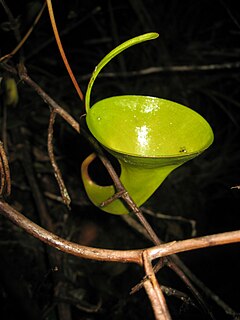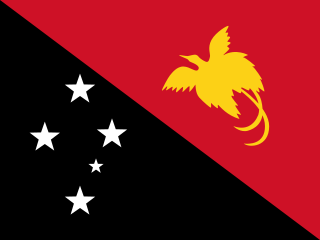
Bromus is a large genus of grasses, classified in its own tribe Bromeae. They are commonly known as bromes, brome grasses, cheat grasses or chess grasses. Estimates in the scientific literature of the number of species have ranged from 100 to 400, but plant taxonomists currently recognize around 160–170 species.

The water deer is a small deer superficially more similar to a musk deer than a true deer. Native to China and Korea, there are two subspecies: the Chinese water deer and the Korean water deer. Despite its lack of antlers and certain other anatomical anomalies—including a pair of prominent tusks, it is classified as a cervid. Its unique anatomical characteristics have caused it to be classified in its own genus (Hydropotes) as well as its own subfamily (Hydropotinae). However, studies of mitochondrial control region and cytochrome b DNA sequences placed it near Capreolus within an Old World section of the subfamily Capreolinae. Its prominent tusks, similar to those of musk deer, have led to both being colloquially named vampire deer in English-speaking areas to which they have been imported. The species is listed as Vulnerable by the IUCN.

Andira inermis is a nitrogen-fixing tree native to the area from southern Mexico through Central America to northern South America ; it has been introduced to the Caribbean, the Antilles, Florida, and Africa. The tree has many names due to its wide distribution and multiple uses: it is also known as the cabbage bark, almendro macho, almendro de río or river almond (Honduras), bastard cabbage tree, cabbage angelin, cabbage bark, cabbage tree, carne asada, guacamayo (Honduras), Jamaica cabbage tree, moca, partridge wood, worm bark, or yellow cabbage tree.

Nepenthes dubia is a tropical pitcher plant endemic to Sumatra, where it grows at an altitude of 1600–2700 m above sea level. The specific epithet dubia is the Latin word for "doubtful".

Nepenthes inermis is a tropical pitcher plant endemic to Sumatra. The specific epithet inermis is Latin for "unarmed" and refers to the upper pitchers of this species, which are unique in that they completely lack a peristome.

Navanax inermis, common name the California aglaja, is a large species of predatory sea slug, a marine opisthobranch gastropod mollusk in the family Aglajidae. Navanax is not a nudibranch, even though it somewhat resembles one; it belongs to a more ancient lineage of opisthobranchs called the cephalaspideans or head shield slugs and snails.

Stomatosuchus inermis is an extinct 10 metres (33 ft) long stomatosuchid neosuchian from the Late Cretaceous (Cenomanian) of Egypt. Unlike most other crocodyliforms, it is difficult to determine exactly what S. inermis ate. Its flattened skull had a long, flat, lid-like snout, which was lined with small, conical teeth. The mandible may have been toothless and may have supported a pelican-like throat pouch.

Nepenthes × pyriformis is a natural hybrid involving N. inermis and N. talangensis. It is known only from Mount Talang in Sumatra, to which N. talangensis is endemic. Nepenthes talangensis was only described as a distinct species in 1994. Prior to this it was placed within N. bongso and some of the older literature identifies this hybrid as N. bongso × N. inermis.

The Solomon's naked-backed fruit bat is a species of megabat in the family Pteropodidae. It is endemic to the Solomon Islands.

The marbled grouper is a species of fish in the family Serranidae. Other common names include donkey fish, mutton hamlet, rockhind and sicklefish grouper.
2,3-Dihydroxybenzoic acid is a natural phenol found in Phyllanthus acidus and in the aquatic fern Salvinia molesta. It is also abundant in the fruits of Flacourtia inermis. It is a dihydroxybenzoic acid, a type of organic compound. The colorless solid occurs naturally, being formed via the shikimate pathway. It is incorporated into various siderophores, which are molecules that strongly complex iron ions for absorption into bacteria. 2,3-DHB consists of a catechol group, which upon deprotonation binds iron centers very strongly, and the carboxylic acid group by which the ring attaches to various scaffolds through amide bonds. A famous high affinity siderophore is enterochelin, which contains three dihydroxybenzoyl substituents linked to the depsipeptide of serine.
Aloe inermis is a small, stemless Aloe native to Yemen.

The highlands punaré, Thrichomys inermis, is a caviomorph rodent of South America from the spiny rat family. It is endemic to gallery forest, savanna and rocky outcrop habitats in Bahia State within the Caatinga ecoregion of eastern Brazil at elevations from 260 m to 1030 m. It sometimes nests and often takes refuge in crevices in rock formations, as means of both predator avoidance and moderating temperature extremes. The species tolerates a degree of habitat disturbance. Although hunted, it is considered common throughout its range. Its karyotype has 2n = 26 and FN = 48.

Bromus inermis is a species of the true grass family (Poaceae). This rhizomatous grass is native to Europe.

Sebastes inermis is a species of rockfish native to the northwestern Pacific Ocean, where it occurs off the coasts of Japan and the Korean Peninsula. This species grows to a total length of 35 cm (14 in), and the heaviest recorded specimen weighed 800 g (1.8 lb). This fish is important to both commercial fisheries and the sport-fishing industry. It is also raised to supply market demand. The Japanese seaperches are twice as expensive as European seabass. Sometimes, the Japanese red seaperch is mixed up with Japanese black seaperch and Japanese seabass.

Sepiella inermis, common name spineless cuttlefish, is an edible species of cuttlefish.

Homonoeini is a tribe of longhorn beetles of the Lamiinae subfamily. It was described by Thomson in 1864.
Catapausa basimaculata is a species of beetle in the family Cerambycidae. It was described by Stephan von Breuning in 1940. It is known from Papua New Guinea.
Catapausa bimaculipennis is a species of beetle in the family Cerambycidae. It was described by Stephan von Breuning in 1956. It is known from Papua New Guinea.
Catapausa bispinosa is a species of beetle in the family Cerambycidae. It was described by Per Olof Christopher Aurivillius in 1908 and is known from Papua New Guinea.

















